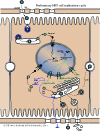Integration into the host genome
Frequency
Persistent HBV replication is associated with a high frequency of integration of HBV sequences into the human host genome while a lower frequency is observed during acute hepatitis B infections (Murakami et al. 2004). They are present in over 85 to 90% of HBV related Hepatocellular carcinomas (HCCs) and usually precede development of HCC.
Sites of integration
HBV DNA integration sites in human HCCs have been found on almost all chromosomes, suggesting a random distribution throughout the host DNA (Tokino et al. 1991). Chromosomal fragile sites are large regions of DNA which replicate late during S phase of the cell cycle and are predisposed to deletions or breaks. There are thus hot spots for foreign DNA integration such as HBV (review: Guerrero et al. 2005). Additionally, various cellular conditions such as exposure to oxidative stress or agents that damage DNA may also favor HBV integration. Actively transcribed regions seem to also favor HBV integration events (Murakami et al. 2005). In HCCs, the integrations observed may no reflect preferred sites but rather locations that confer growth advantage.
Comments:
Many nuclear viruses are able to perform occasional integration, and it is not surprising that HBV is able to do so, although integrated HBV are presumably defective. The enrichment of integration in HCC might be related to the possible loss of HBV genome during mitosis. If this is true, there would be a strong selective advantage in favor of HCC cells having integrated the viral genome, playing a role in oncogenesis.


